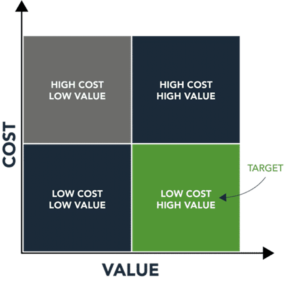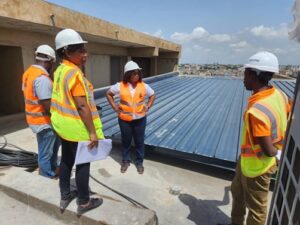As the good book says, “Anyone who wants to build should first sit down and calculate the cost to see if there is enough money to finish it”. The budget is one of the most important aspects of any project as it essentially lays the foundation for managing costs and timelines throughout the project. Dreams are free but construction is not. Thus, it is necessary that you chart your course to build a budget that works.
A: Define project objectives and scope
Now that you have planted the seed of clarity and have determined the look and feel of your dream project, relay these ideas to your professional ally, preferably the architect. Your design brief is the DNA of the project. Do you want a three-bedroom house with an outhouse or a 1000-seater auditorium? Perhaps, it is a pre-school with a hurt-free playing field. Upon several interactions with your architect, more specifications inform the design. Floor tiles are preferred for the living room and loose flooring for the outdoor parking area. Perhaps, fair-faced concrete for the pedestrian walkways and a Zen Garden near the entrance or maybe a water feature.

B: Attain preliminary cost estimation
After discussing your design brief, free feel to ask your architect, preferably one with construction experience, to give you a rough estimate (guesstimate) of your project. Based on historical cost data, she will come to you with a guesstimate. The guesstimate is not necessarily the actual cost of the project. It is for budgetary purposes only, to help you make a “go” or “no go” decision. It is simply to give you a general idea of the cost range so you can compare it with the budget you had in mind. Perhaps, the one you had in mind was a bit unrealistic. Or rather, the architect’s guesstimate is lower than the high-end edifice you want. Make adjustments were necessary and move forward.

C: Execute building feasibility analysis
Project Feasibility Analysis helps you avoid project pitfalls and uncover opportunities. You will be able to understand the challenges and constraints facing your project and will give you a good foundation to proceed with your project.
This analysis of important factors such as a report on the preliminary programme, schedule of services, fee proposal, relevant data and information pertaining to legal issues, land regulations, market research, potential revenues, return on investment (ROI), technical challenges, permits and licenses and so much more.
Perhaps, you want to build a dozen 2-storey buildings on a service plot as a developer. There is a need to know your return on investment. The nature of certain projects gives it the potential to receive external funding. Certain projects will even require a Traffic Impact Assessment. Certain locations also have building height limits.
Due to the location or the building height, certain sites require soil tests. The project feasibility analysis will reveal all pre-construction costs; land costs, construction costs, design and consultancy fees, agency fees (in the case of having a real estate agent), permit fees, decorating costs and other sunk costs.


Visit https://spektra.global/first-steps/project-feasibility-analysis/ today to start your Project Feasibility Analysis now
D: Establish budget parameters:
If after the feasibility analysis, you realize you have the financial capability to go on with the project, the next thing to do is to establish your budget parameters. To do so, first ascertain your financial options.
Are there any funding sources you can leverage on? Can financial arrangements be made with stakeholders and developers? Will the project be personally funded? Clarify the project priorities within the budget, cogitate the financial risks and funding constraints and consider the financial ceiling of the project.
Also, look into how operational efficiency can yield financial benefits and how risk management strategies will be incorporated right from the start. Establishing realistic budget parameters from the onset cannot be overemphasized.
E: Incorporate contingency allowances
Due to the instability of the economic climate, it is key that you factor in the fluctuations of prices over the course of the project. Although the project feasibility analysis may propose a desired timeframe for construction, not factoring in contingencies will only blow your project high of course or cause it to halt if the intended budget is impacted by economic instability. Contingency is simply a provision to cater for unexpected circumstances – typically financial – that may arise during the course of the project. It involves setting aside resources such as money, time and/or materials. Time is money, and construction is proof that it really is. The more the project delays, the higher the expenditure. Time contingency is a buffer built into project schedules to account for unexpected delays or disruptions. With regard to contingency funds, a percentage of the total project cost (5% to 10%) is set aside within the project budget to cover unforeseen expenses such as price fluctuations.

Value Engineering (achieving a low-cost, high value project) can only be achieved when well-experienced building professionals are on board
F: Embrace Value Engineering
Value engineering refers to optimizing project costs without compromising quality or performance. It is tempting to cut corners by using cheaper materials in a quest to save extra money or a move to restrict expenditure from exceeding the budget limit. Although durable and quality materials may be very expensive beyond the budget allocation, building professionals with adequate construction experience can leverage low-cost, time-saving, efficient as well as affordable materials, appliances, technology and construction methods that are well within the time and cost constraints. Only a professional can achieve value engineering for you. This leads me to the most important point:

G: Seek professional guidance at all stages
Not involving an architect (or design-build expert) in this entire process is financial suicide. The architect is your professional ally. Such an expert has the prerequisite knowledge and experience to handle the project from start to finish. The architect does not work alone, however. Other professionals in the building industry will join in along the course of the project. Do well to collaborate with experienced professionals to navigate the complexities of budgeting and leverage their expertise to develop realistic budgets, optimize cost-saving opportunities and mitigate financial risks effectively.
About Karen Evans Halm (A.G.I.A)
Karen Evans Halm is the Principal Architect / co-founder at Spektra Global Limited. Her expertise span across architecture, interior design, landscape design and building construction.
You can reach her via [email protected] / +233 262 858473










